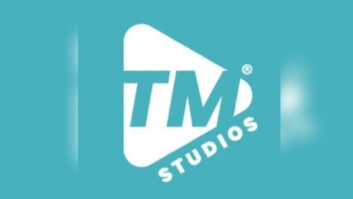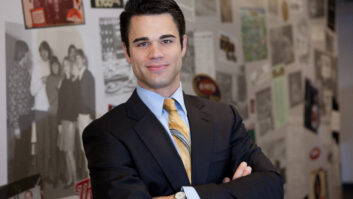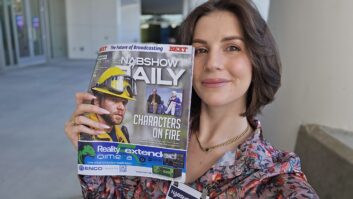
Greg Clancy You’re listening to your favorite station in the car. A cluster of commercials finally ends, a band kicks in and a group of singers belts out: “94.5 — Kool-FM” or “Music and friends to start your day, big fun and family, Spirit 105-3.”
These 10-second wonders are known in radio parlance as jingles, and many of them come from TM Studios, a full-service production house in Dallas. By “full-service” we mean that TM, in addition to creating sung station identification jingles, purveys other items of an audio nature that radio stations use: production music libraries, instrumental logos, voiced promos and anything else that can be used for audio branding.
TM Studios was founded in the late 1960s and is the oldest jingle company in Dallas, although it has undergone several minor changes in name and several major changes in ownership. Its past owners include its founders (broadcaster Jim Long and the late arranger Tom Merriman), Shamrock Communications and Disney/ABC; today it is owned by Westwood One, part of Cumulus Media.
MORE CONTROL
Greg Clancy, now general manager/vice president creative at TM Studios, is a second-generation jingle singer. His father, Jim Clancy, sang bass for various Dallas producers beginning in the late ’60s. Clancy the younger not only sings, but is also an arranger/producer/businessman.
“The style and culture of music have changed, and jingles have shifted dramatically even over the last few years,” he said. “In years past you needed singers who knew how to blend with other singers. We still use vocal groups, but they are smaller and more contemporary. The old five-voice group sound has aged out.

Inside the control room — the crew uses an SSL C300 console. “Now what we look for is the sound of the individual singer. And we rarely have several singers at a single microphone. Each singer has his/her own mic, which gives us more control over pitch or aligning corrections we need to make after the session.”
And not only are there fewer singers these days, they may not even be in the same room together.
“The great thing about TM is that we have followed the evolution in technology. We use an SSL C300 console and Pro Tools HD with all the latest plug-ins,” Clancy said.
“Often we use vocalists in different parts of the country. We’ll have a singer in Orlando and add a Dallas singer. They perform together virtually, even though they don’t know each other. What’s fun is we can pass sessions around from different parts of the world. When we use musicians in Nashville for a country session, they send the music over to us digitally; we open it here and can mix it or add singers. Someone can touch a session in Dallas, then in Europe, and finally the jingles get delivered to Canada. It’s a smaller world with this technology. At TM we now have a sound that’s agnostic from a geographical standpoint. We can sound like Los Angeles, Europe or whatever we need to come up with to compete.”


A classic jingle session Musicians lay down a track or two.
Clancy adds, “We have our own in-house FTP site that we use for most of our off-site track transport. We have also used Dropbox and WeTransfer as well.
MUSIC AND MEMORY
The concept of branding has been well known to advertisers for decades. Brief yet distinctive musical sounds, like the five-note logos for Intel and McDonalds, are heard on radio and TV and instantly trigger brand recognition.

“Intel took something people don’t understand, like a microprocessor, and they made it friendly and relevant by putting a sound to it,” said Clancy. “People are once again realizing the value of branding something sonically, even if there’s no singing involved. Think about the NBC chimes! With radio, you may only have the attention of a listener for 15 minutes a few times a week, so there is very little time to make an impression.
“Radio stations have to make sure their branding is consistent around the clock. We try to write logos that get stuck in people’s heads. A seven-second jingle has to have as much care and craftsmanship as the three-minute song that preceded it.”
TM is aware of how its products are perceived over the air.
“Contemporary Christian and country artists release two versions of their hits, one for consumers to buy on iTunes, and one for broadcast,” said Clancy. “The broadcast one will have less compression. The reason is that by the time a song goes through the station’s processing chain with limiters and EQ, a really compressed song will sound smaller. We want our jingles to sound big, rich and expensive, so we’ll work with the stations on a case-by-case basis to determine what kind of processing to use.”
BEST PRICE IS FREE
In the late 1950s, many radio stations got jingles on a barter basis from companies like PAMS of Dallas or Pepper Tanner in Memphis. Stations would air commercials for an advertising agency that would get paid by its advertisers. The agency would then purchase the jingles from the producers. This arrangement fell out of fashion as economics changed in the 1960s, but now barter is back.
TM’s Kit
Per Greg Clancy, here are some tools that the TM Studios crew uses in their production workflow:
Microphones: We tend to use our Telefunken 251, Neumann U 47 and U 87, and an Audio-Technica 4060 for our vocals. A combination of AKG 414s, the Neumanns, Sanken SU-41s and our Royer 122 works well for our brass and string sessions.
Processors: We will make use of our outboard reverb boxes, which include a Lexicon 224X and a TC Electronic M-One.
Software: We have accumulated various plug-ins for our Pro Tools systems. I would say that the largest set that we tend to use is from Waves. Aside from the traditional handwritten music adaptions, some of our writers will use the music notation that is built into Logic, and others use iterations of Finale.
“Because of our relationship with Westwood One and its clients, we can use barter,” said Clancy. “In fact, barter represents the majority of our business. It’s great because stations don’t have to put forth cash to get jingles.”

Greg Clancy also fulfills several non-musical functions at TM Studios.
“I spend half my time writing, producing, singing and leading vocal groups. Then I’ll get on the computer and make deals with producer/partners, talk to clients and handle employee issues. It’s just all over the map, and I love it. The day goes by in five minutes.”
TM’s website is www.tmstudios.com. Its blog has tips on producing jingles and other notes on the company.
Ken Deutsch is a former jingle writer whose books can be found at http://kendeutsch.com/books.htm.
Got an idea for a studio profile in Radio World? Write to [email protected].







